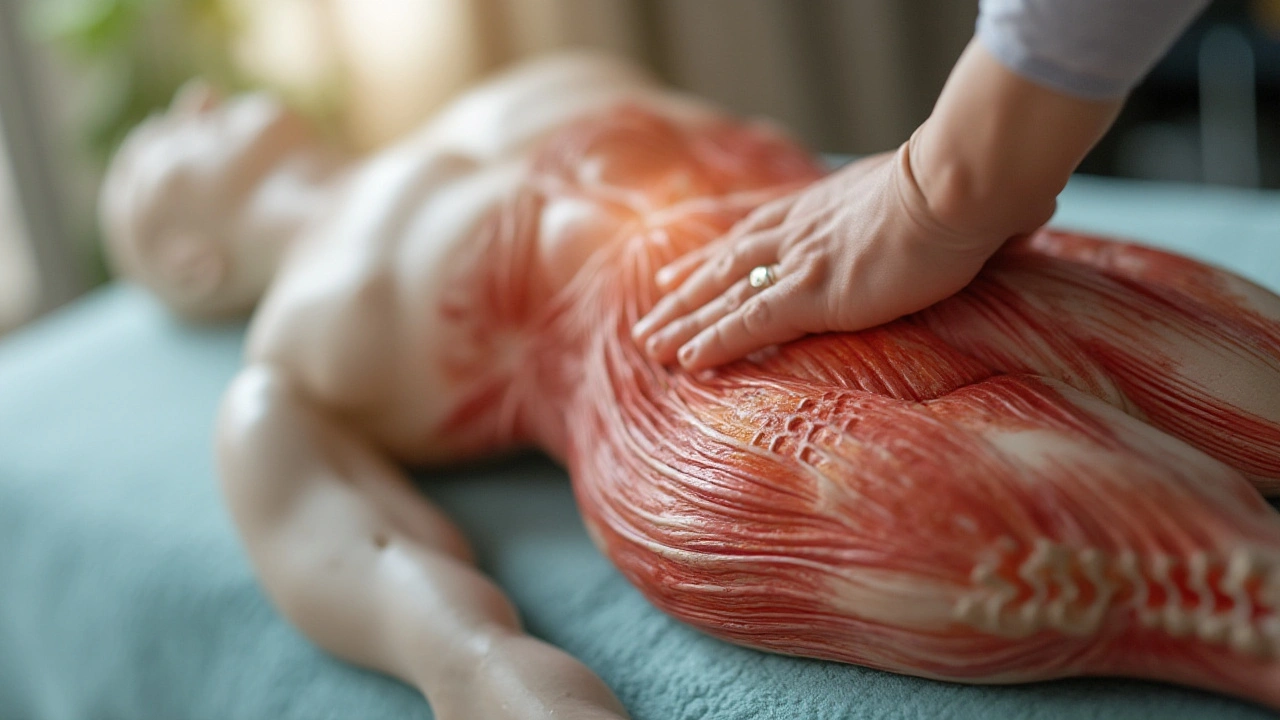Mastering Trigger Point Massage Techniques for Pain Relief

Trigger point massage is much more than just another massage technique; it's a strategy for alleviating some of the most common and persistent forms of muscle pain. This method zeroes in on precise spots in the muscle tissue that are consistently tight or tender, often described as 'knots'. These knots can disrupt the flow of blood and oxygen to muscles, creating a vicious cycle of tension and discomfort.
Although pinpointing these spots might sound complex, understanding the nuances of trigger points can lead to effective relief and long-term benefits. Yet, it's not just about pressing on a painful spot. There's a technique involved that requires understanding the body's anatomy and knowing how to apply pressure correctly. This doesn't just reduce current discomfort but can also prevent future pain, leading to improved overall muscle health.
In this article, we'll delve into what makes trigger points tick, the techniques involved in addressing them, and how this practice can be woven into everyday life for sustained wellness. It's time to take a closer look at the art of trigger point massage and its remarkable ability to enhance your well-being.
- Understanding Trigger Points
- Benefits of Trigger Point Massage
- Techniques and Tools
- Incorporating It into Your Routine
Understanding Trigger Points
Trigger points, often referred to as muscle knots, are fascinating yet troublesome areas that exist within taut bands of skeletal muscle fibers. These points are not just vague spots of pain but rather precise areas where the muscle fibers are locked in a state of contraction. When these trigger points are activated, they can cause aching, soreness, and even refer pain to other areas of the body. This referred pain phenomenon is why sometimes the location of discomfort is not necessarily the source of the problem.
The science behind trigger points involves complex interactions between muscle fibers, the nervous system, and biochemical processes. Researchers have identified specific proteins, such as myosin and actin, which are involved in muscle contraction, but when a trigger point forms, these proteins can become misfired, leading to sustained contraction. This continuous state of contraction restricts blood flow, resulting in a lack of oxygen and an accumulation of metabolic waste, which contributes to persistent pain. Did you know that around 85% of individuals experience muscle pain due to trigger points at some point in their lives?
Developing an awareness of where these points commonly occur can be beneficial. For instance, in the upper back near the shoulder blades, many people encounter discomfort that stems from these pesky nodules. The tension in these points is often a result of poor posture, stress, or repetitive motions.
Dr. Janet Travell, renowned for her work on myofascial pain, once noted, "Understanding the nature of pain means we need to treat who the person is, and not just what the disease entity is."This highlights the need for a holistic approach in addressing trigger points, focusing not only on physical symptoms but also considering emotional and lifestyle factors contributing to muscle tension.
Addressing trigger points is a journey of discovery and requires a nuanced understanding of not just where pain occurs, but what lifestyle factors might be contributing to it. Staying mindful of triggers like prolonged sitting or sustained emotional stress is key. By consistently engaging in mindful stretching and stress-reduction techniques, it's possible to reduce the frequency and intensity of trigger point activation. Discovering the right balance in therapeutic approaches can not only provide relief from discomfort but also enhance overall muscular wellness, paving the way for a more active and pain-free lifestyle.

Benefits of Trigger Point Massage
The impact of trigger point massage on one's well-being goes far beyond simple relaxation. It is renowned for significantly reducing muscle tension, targeting those stubborn knots that many people experience. By focusing pressure on these points, blood circulation improves, delivering much-needed nutrients and oxygen to strained areas. This enhanced circulation accelerates healing and reduces inflammation, creating a domino effect of relief throughout the body.
This type of massage can drastically reduce pain in areas that are often a source of chronic discomfort for individuals. For instance, those suffering from tension headaches or joint stiffness can find solace in this therapeutic approach. Trigger point massage assists in releasing endorphins, which are natural painkillers and mood enhancers. This release not only diminishes pain but also contributes to an overall sense of well-being, helping to alleviate symptoms of stress and anxiety.
One engaging aspect of this massage technique is its potential to improve range of motion. By releasing tight muscles, joints become more flexible, promoting better movement and functional fitness. A regular routine of trigger point massage can make physical activities more enjoyable and less painful. Whether it's a morning run or simply playing with the kids, improved mobility changes lives in subtle yet profound ways.
Dr. Janet Travell, the pioneer of Trigger Point Therapy, aptly noted, "You can eliminate or control pain by controlling tension in muscles, if you know where the trigger points are to release the tension."
Another noteworthy benefit is that it empowers individuals with a deeper awareness of their own bodies. By identifying and understanding these pressure points, people can self-manage their wellbeing. Learning these techniques ensures that one can provide relief not only to oneself but also to friends and family, creating a community of wellness. This proactive approach to health not only extends the benefits of massage but also teaches patience and persistence in treatment.
There is compelling data supporting these advantages. For example, studies have shown that about 74% of individuals who incorporated trigger point massage into their routine reported a significant decrease in chronic pain.
| Benefit | Reported Improvement (%) |
|---|---|
| Pain Reduction | 74% |
| Mobility Enhancement | 68% |
| Stress Relief | 82% |

Techniques and Tools
When diving into the world of trigger point massage, understanding the techniques and tools involved is paramount. The essence lies in applying precise pressure to those troublesome spots known as trigger points. These points can sometimes feel like small nodules or tight bands within the muscle, and recognizing them by touch is the first step. The pressure applied should be deep enough to feel a change but should never cross into causing sharp pain. Rather, a well-executed trigger point massage involves a blend of deep tissue techniques and specific methods like circular friction or sustained pressure for up to 90 seconds.
Determining the right amount of pressure is both an art and a science, requiring a firm yet controlled touch. It's in these moments that using your elbows, knuckles, or specialized tools such as massage balls can be useful. Tools like foam rollers or massage sticks are fantastic for self-application, helping reach otherwise inaccessible areas. They allow for variation in pressure and motion, keeping the process effective without causing strain on the hands. In some cases, electrical massagers with special attachments can supplement hand techniques for a more dynamic approach.
Instruction is another critical aspect, and consulting resources like educational videos or massage courses can greatly assist in honing these skills. According to a well-regarded study published in the Journal of Bodywork and Movement Therapies, a majority of individuals who combined professional guidance with self-massage techniques reported significant reductions in muscle discomfort and improvements in mobility. One of the more advanced techniques involves sequential release, which aims at systematically relaxing surrounding trigger points before focusing on the core area of tension.
"It's about coaxing the muscle to release," notes renowned massage therapist Tom Myers, "Without forcing it, respecting the tissue's limits is key to effective relaxation."
Massage sessions can be structured depending on individual needs. For instance, a targeted session might focus solely on the upper back for 15 minutes, while a comprehensive session could include both arms and legs over an hour. Being versatile in technique allows for tailoring each session to the tension patterns of the individual.
There's also an increasing trend in massage circles towards integrating technology. Applications and smart tools offering guided sessions are available, using sensors to measure muscle tension and provide feedback on technique. Although these offer valuable insights, they should complement rather than replace hand techniques, emphasizing the importance of initial tactile assessment and direct contact for an authentic massage experience.
In summation, perfecting trigger point massage requires a thoughtful combination of tactile skill, informed technique, and the right tools to suit the particular needs of each individual. From the traditional hands-on approaches to the inclusion of modern technology, mastering trigger point therapy is about adaptability and precision.

Incorporating It into Your Routine
Integrating trigger point massage into your daily routine doesn’t have to be a complex process, but it does require intention and a bit of knowledge. The first step is to identify the times during your day when you can devote a few minutes to your well-being. Perhaps you have a quiet moment in the morning or a lull in activity during the afternoon. Carving out even just ten minutes a day can be immensely beneficial. During these moments, think about the areas of tension that persistently bother you, such as shoulders, neck, or lower back, all common targets of trigger points.
Once you have set aside this time, decide whether you'd prefer self-massage or assistance from tools specifically designed for trigger point therapy. Tools like foam rollers, tennis balls, or specialized massage equipment can make a world of difference when trying to access deeper layers of muscle. Consistency is key, and making use of these tools can offer greater precision and relief over time. It's important to listen to your body; the pressure should feel uncomfortable yet tolerable, akin to the sensation of a good workout.
If you're new to massage therapy, consider reaching out to a certified professional at first. They can provide insights and techniques that you can apply at home. It’s worthwhile to ask questions and maybe even jot down notes on what you've learned. Armed with this knowledge, you can develop a regimen that addresses your unique needs. Once you learn how to identify and work through trigger points effectively, you can adapt the routine to fit your lifestyle, ensuring a regular and structured approach.
Dr. Janet Travell, a pioneer in the field of trigger point therapy, famously said, "The person who can manage their pain through trigger point therapy truly holds the key to their comfort." Her words emphasize the importance of taking charge of one's own health journey, and how regularly addressing trigger points can be seen as a crucial part of a holistic self-care routine.
Lastly, pay attention to your progress. Track how your body responds over weeks and months. Sometimes, keeping a simple journal of your experiences with trigger point massage can shed light on patterns and highlight which methods are the most effective. While results may not be immediate, consistency pays off, leading to reduced pain and improved functionality.
Remember that as you incorporate these practices into your routine, patience and persistence are vital. Life's pace may vary, but taking time for your body can have lasting benefits. Whether used in conjunction with other wellness activities or as a solo practice, trigger point massage holds the potential to transform your daily habits and beckons a future where discomfort is no longer a constant companion.





